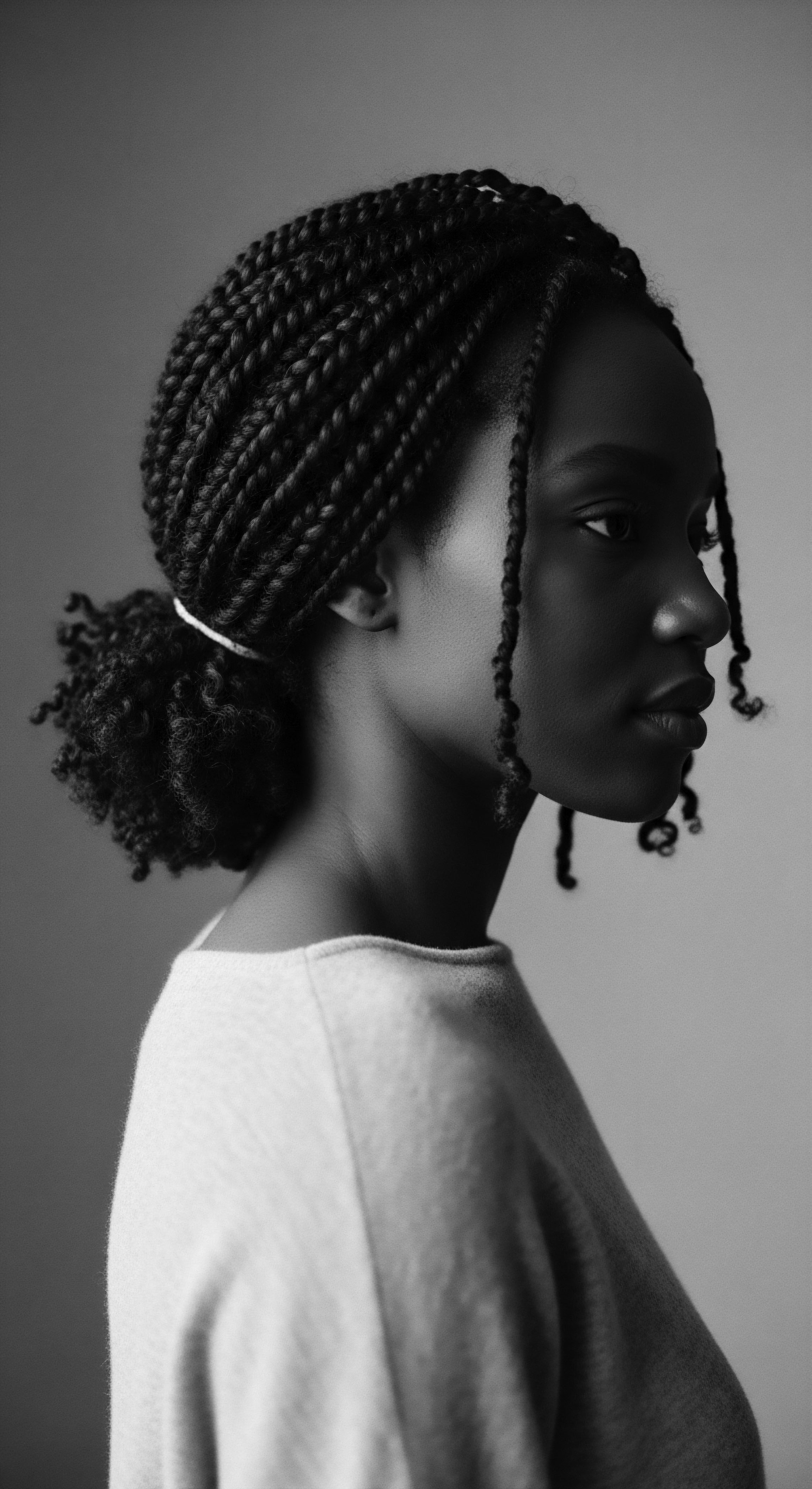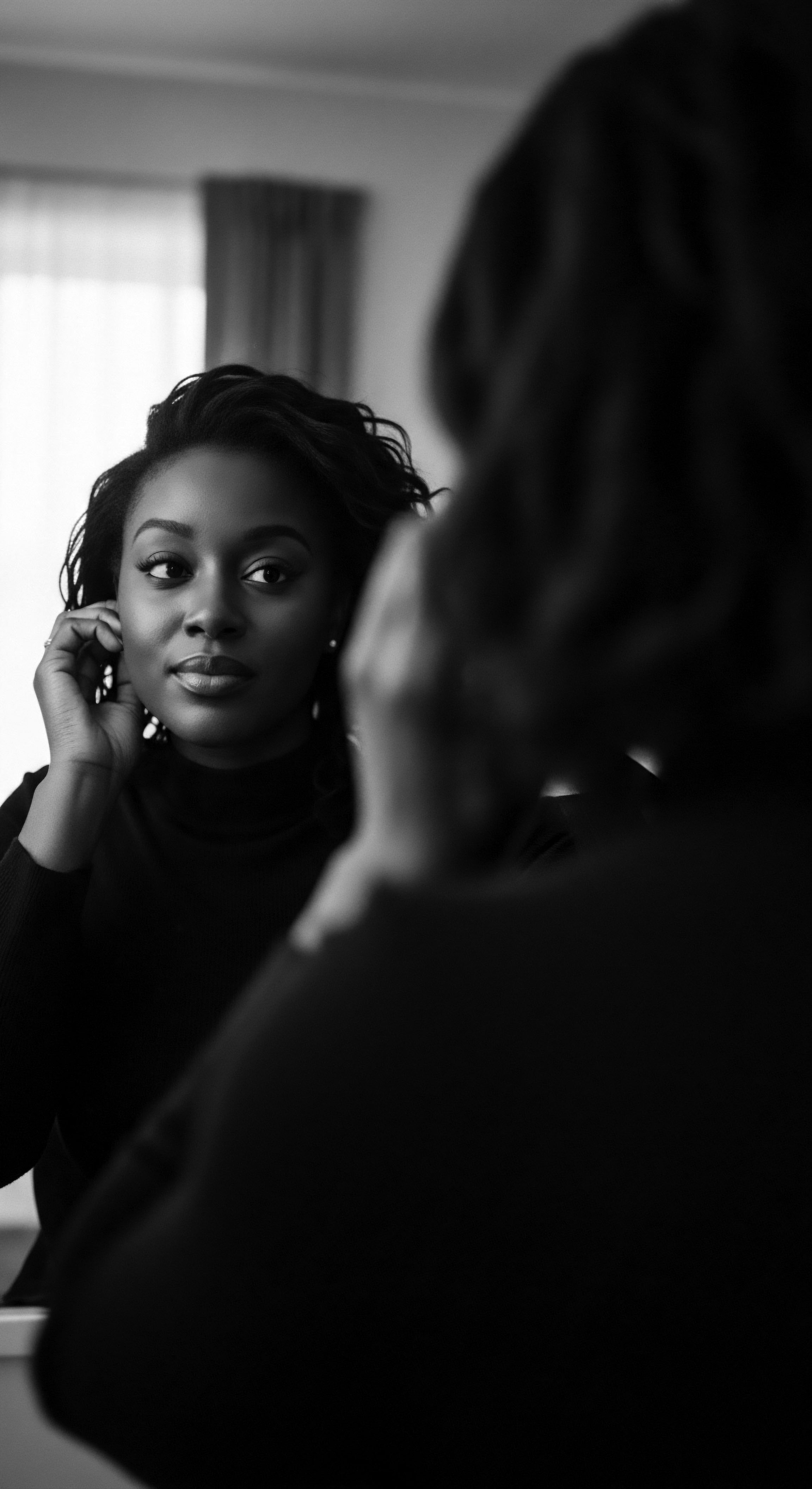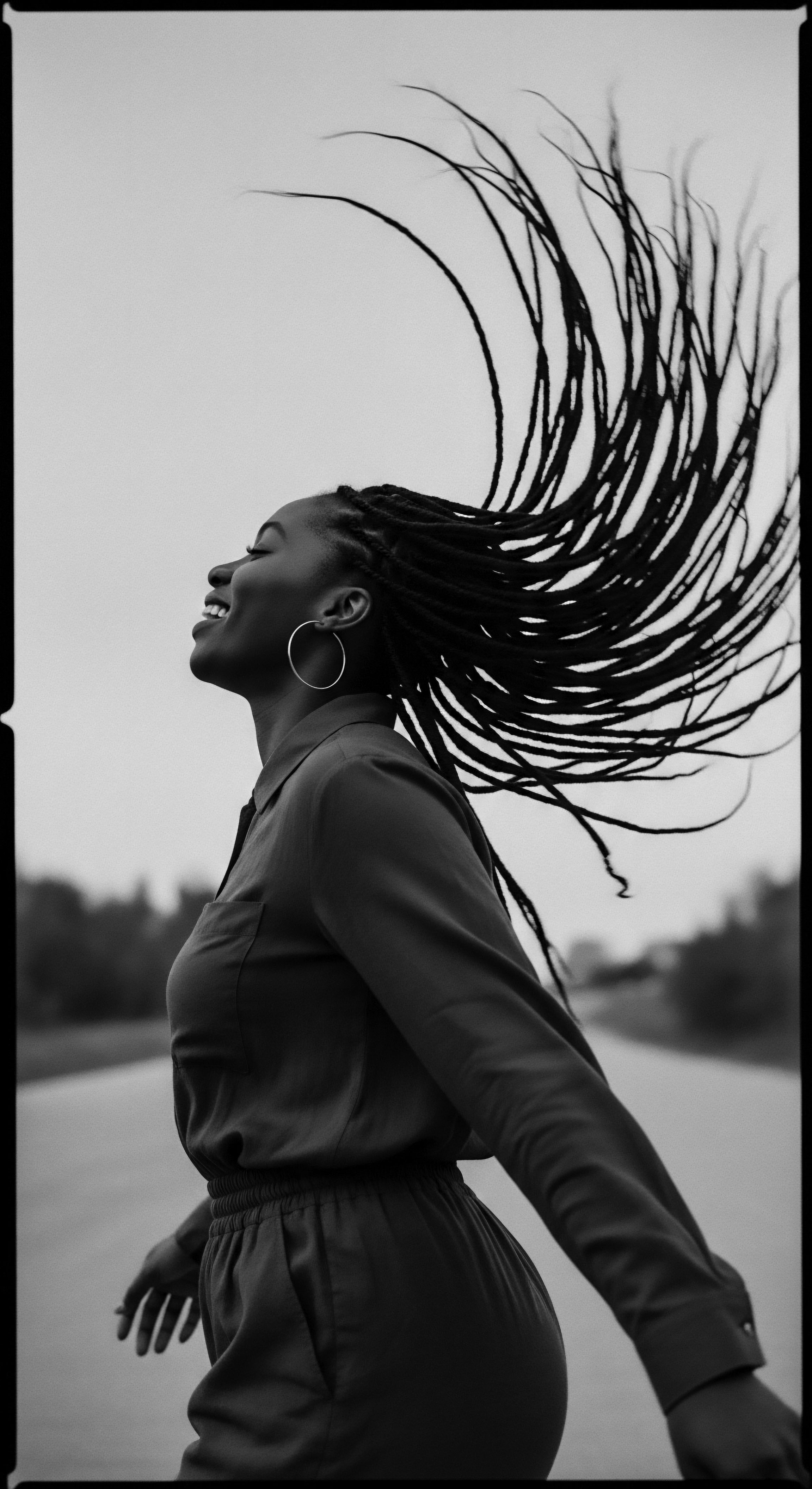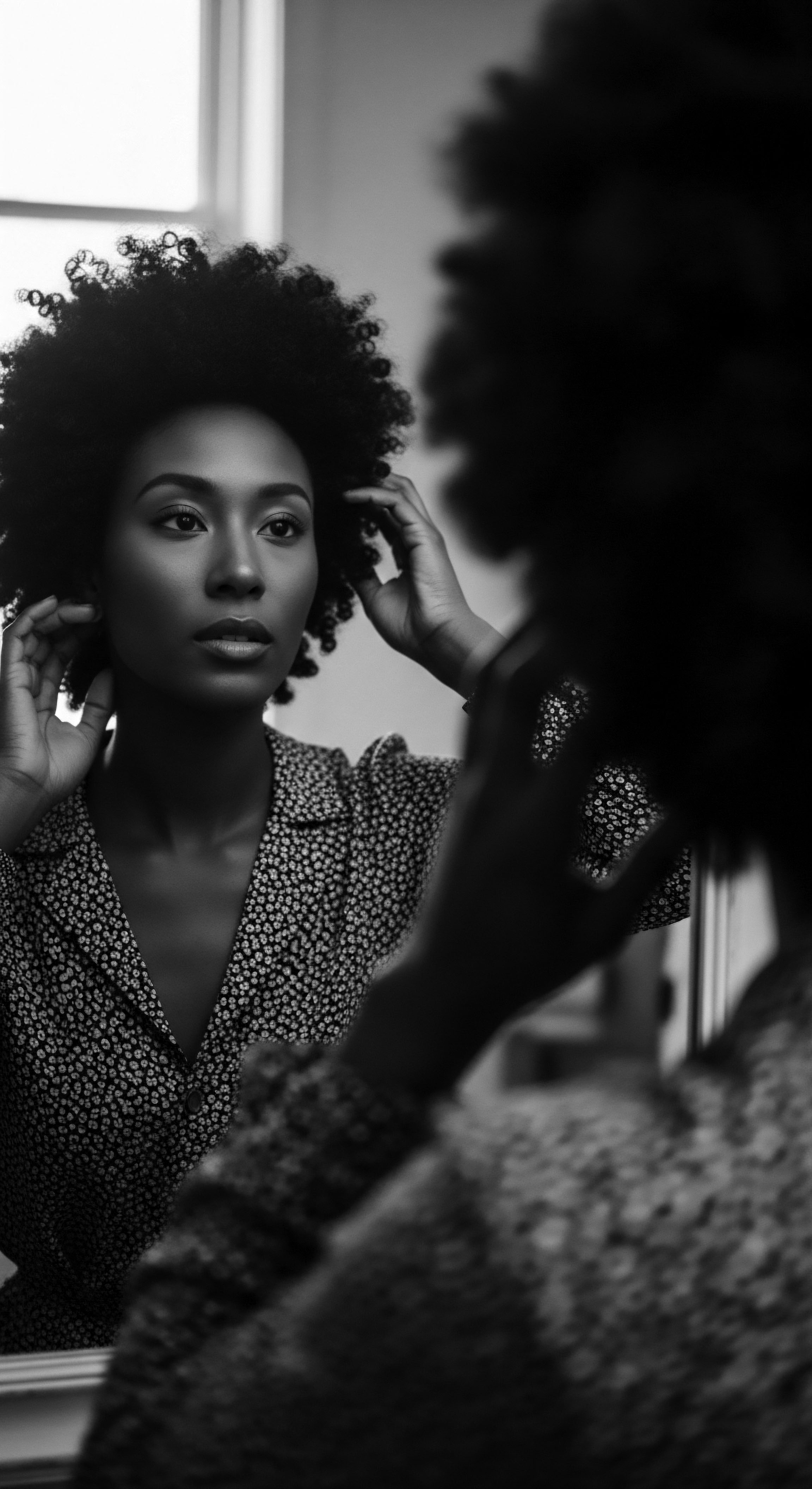
Roots
Across generations, the very fibers of our textured hair have spun tales far older than mere follicle and strand. They whisper of collective memory, of resistance quietly braided into existence, and of a profound kinship that has long nourished the spirit. For those of us whose lineage traces through Black and mixed-race experiences, textured hair is not simply a biological marvel; it is a living archive, each coil and curl a testament to ancestral ingenuity and a vibrant, unbroken chain of communal wisdom. To comprehend the deep resonance between modern textured hair movements and the enduring communal bonds of yesteryear, we must first attune our senses to the earliest echoes from the source, recognizing the very language and structure of this glorious crowning glory.
The intricate world of textured hair anatomy, a study in delicate strength, speaks volumes of its resilience. From an ancestral perspective, knowledge of hair’s inherent structure was not relegated to academic texts but lived within the practiced hands of elders and caregivers. The hair shaft, a complex protein matrix, unfurls from the scalp, its elliptical or flattened cross-section giving rise to the characteristic bends, twists, and coils we recognize. This unique architecture, differing significantly from straight hair, influences how moisture is held, how oils traverse the strand, and how light dances upon its surface.
Ancient peoples understood these intrinsic properties, not through microscopes, but through generations of careful observation and intuitive interaction with their own tresses. This observation formed the bedrock of care practices, passed down orally, physically, from one skilled hand to the next, cementing communal learning as a primal force.

Ancestral Understanding of Hair’s Architecture
Pre-colonial African societies possessed sophisticated classifications for hair textures, often far more nuanced than contemporary systems. These distinctions were not solely aesthetic; they were integral to social stratification, spiritual practices, and even communication within a community. For instance, in many West African cultures, specific braided patterns or hair adornments could signal marital status, age, tribe affiliation, or even a person’s role in society.
This comprehensive understanding meant that hair was viewed as an external extension of self and community, a living canvas upon which collective identity and individual narrative converged. The language around hair was therefore deeply embedded in the social fabric.
Textured hair, beyond its biological architecture, serves as a living repository of ancestral wisdom and communal narratives.
The essential lexicon of textured hair, whether traditional or contemporary, always speaks to this layered understanding. Terms like ‘kinky,’ ‘coily,’ ‘wavy,’ and ‘curly’ attempt to categorize the infinite variations. However, historical terms often carried deeper, more culturally specific meanings. For example, specific patterns of braiding, often named after animals or natural phenomena, were not just styles; they were symbolic messages, prayers, or historical records.
The very act of naming and classifying hair types and styles became a collective enterprise, a shared language that affirmed belonging and continuity. This communal recognition fostered a sense of shared heritage, where each individual’s hair was seen as part of a larger collective expression.

How Did Hair Growth Cycles Inform Traditional Care?
Understanding hair growth cycles, even without modern scientific terminology, was intuitive to ancestral practitioners. They observed the shedding, the new growth, the periods of vibrancy, and those of fragility. Factors influencing hair growth – diet, climate, emotional wellbeing – were keenly noted. Traditional healing systems often linked hair health directly to internal balance and environmental harmony.
For example, certain foods or herbs known for their nourishing properties for the body were also applied topically to the hair, reflecting a holistic view where the body and its adornments were inextricably linked to the land and its bounty. This knowledge, shared across families and communities, ensured that care was a perpetual, adaptive practice.
- Adornment ❉ The practice of embellishing hair with beads, cowrie shells, or gold, often signaling status or spiritual connection.
- Braiding ❉ A communal activity, frequently a multi-hour process that facilitated storytelling, knowledge transfer, and intergenerational bonding.
- Combs ❉ Hand-carved implements, often imbued with symbolic meaning, used for detangling and styling, passed down as heirlooms.

Ritual
The journey of textured hair care has always been steeped in ritual, a rhythmic dance between tradition and transformation. This rhythm extends far beyond superficial adornment; it speaks to deeper connections, to the legacy of practices that were not merely about appearance but about sustenance, communal identity, and quiet acts of resilience. Modern textured hair movements, in their resurgence of natural styles and mindful routines, undeniably mirror these historical communal bonds, re-establishing hair care as a shared, deeply significant endeavor.

Protective Styling Through Generations
Protective styling, a cornerstone of contemporary textured hair care, finds its deepest roots in ancestral wisdom. Across the African diaspora, styles like braids, twists, and locs served not only to protect the hair from environmental damage but also as powerful cultural statements. These were not quick fixes; they were often elaborate, time-consuming endeavors that necessitated communal participation. A mother might braid her daughter’s hair, a sister might help another with intricate patterns, or village women might gather, sharing stories and songs as hands worked in tandem.
These were moments of intimacy, trust, and shared vulnerability, solidifying bonds that stretched beyond the individual. The legacy of these styles speaks of a continuity that transcends colonial interruptions.
In many African societies, the act of braiding or styling hair was a significant social event. Knowledge of specific techniques, passed down through generations, became a prized skill within the community. For instance, among the Fulani people of West Africa, a style known as the Fulani Braids or ‘paten’ often includes intricate patterns, sometimes adorned with cowrie shells and amber beads, signifying wealth or marital status.
These styles required hours, sometimes even days, to complete, during which women would share stories, advise, and reinforce social ties. This collective effort, rooted in the preservation of hair health and cultural expression, provided a tangible framework for communal cohesion.
Hair rituals, from protective styling to shared care moments, represent a timeless language of community and cultural continuity.

How Did Ancestral Methods Inform Natural Hair Definition?
Natural styling and definition techniques, so popular today, also echo methods practiced for centuries. Before commercial products, individuals relied on natural emollients, plant extracts, and water to cleanse, moisturize, and define their coils. The efficacy of these methods was observed and refined collectively.
Knowledge of specific plants, their properties, and their application for hair care formed a body of ancestral wisdom, freely shared within the communal sphere. The understanding of what defines a particular curl pattern or how to achieve maximum elongation was a communal observation, an empirical science born from generations of hands-on experimentation within the collective.
The utilization of natural elements for hair care is a practice deeply ingrained in many African traditions. For example, Shea Butter (Vitellaria paradoxa), derived from the nuts of the shea tree, has been used for centuries across West Africa for its moisturizing and protective properties on both skin and hair. Women would collectively gather, process, and apply this rich butter, often accompanying the ritual with communal singing or storytelling. The preparation of these natural ingredients, often a laborious process, became another opportunity for shared labor and intergenerational teaching, cementing communal ownership over these vital practices.
| Aspect Knowledge Transmission |
| Ancestral Practice Oral traditions, intergenerational teaching during hair sessions |
| Modern Parallel Online tutorials, social media groups, natural hair meetups |
| Aspect Hair Protection |
| Ancestral Practice Intricate braids, twists, wraps for long-term wear |
| Modern Parallel Box braids, faux locs, weaves, wigs for length retention and style versatility |
| Aspect Product Sourcing |
| Ancestral Practice Local plants, natural oils, homemade preparations |
| Modern Parallel Artisan brands, DIY recipes, emphasis on clean ingredients |
| Aspect The enduring quest for hair health and expression binds historical and contemporary practices. |

Beyond Adornment ❉ Wigs and Extensions as Cultural Artifacts?
Wigs and hair extensions, often perceived as modern trends, also possess a rich historical lineage, particularly within African cultures. They were used not merely for aesthetic purposes but for spiritual reasons, as symbols of status, or for practical reasons such as protecting natural hair. In ancient Egypt, elaborate wigs were worn by both men and women, signifying social standing and religious devotion.
These were not individualistic statements but reflections of collective norms and aspirations. The artistry involved in crafting and maintaining these pieces was often a communal endeavor, requiring specialized skills shared and refined within a group.
The tools of textured hair care, from ancestral combs to contemporary brushes, represent a tangible connection across time. Traditional combs, often carved from wood or bone, were sometimes passed down as sacred objects, imbued with the wisdom of those who had used them before. The care taken in creating these tools, and the reverence with which they were handled, mirrored the respect accorded to the hair itself.
Today’s specialized brushes and detangling combs, while technologically advanced, serve the same fundamental purpose ❉ to navigate the unique contours of textured strands with care. The shared journey of invention and adaptation, from natural materials to engineered solutions, speaks to a continuous, collective pursuit of optimal hair well-being.

Relay
The journey of textured hair, from ancient communal rites to vibrant modern movements, is a compelling relay of resilience, identity, and shared knowledge. These contemporary expressions are not emerging from a vacuum; they represent a powerful re-affirmation of long-standing communal bonds, shaped and refined through centuries of experience. This intricate interplay, where the past continually informs the present, forms the very soul of textured hair heritage.

How Do Modern Movements Mirror Historical Collectivism?
Modern textured hair movements, particularly the Natural Hair Movement, exemplify a potent mirroring of historical communal bonds. During the eras of forced assimilation and cultural suppression, hair care often became a private, sometimes solitary, struggle. However, historical records reveal that even in the most challenging circumstances, Black communities found ways to sustain shared hair practices. During slavery in the Americas, for example, the communal practice of hair braiding among enslaved women was not only a means of caring for hair but also a vital act of resistance and a conduit for transmitting cultural memory.
Women would gather, often under the cloak of night, to braid each other’s hair, sharing stories, strategies for survival, and ancestral knowledge. This shared activity reinforced solidarity, serving as a powerful counter-narrative to dehumanization and isolation. Dr. Ayana Byrd and Lori Tharps, in their significant work Hair Story ❉ Untangling the Roots of Black Hair in America (2001), document how these clandestine sessions were pivotal in maintaining a sense of self and community, even as external forces sought to dismantle them. This deeply personal yet collectively practiced ritual provided psychological solace and fostered an underground network of shared resilience.
Today, the resurgence of natural hair in mainstream consciousness has recreated these vital communal spaces, albeit in new forms. Online forums, social media groups, and YouTube channels act as virtual gathering places where individuals share tips, frustrations, product recommendations, and personal journeys. These digital spaces replicate the knowledge-sharing and emotional support found in historical communal hair care sessions.
Local natural hair meetups, festivals, and pop-up salons further solidify these connections, offering tangible spaces for individuals to connect, learn, and celebrate their shared heritage in person. The collective embrace of natural texture becomes an affirmation of identity, a reclamation of beauty standards, and a powerful statement of unity.
Modern textured hair communities, from virtual forums to real-world gatherings, powerfully echo ancestral practices of shared knowledge and mutual support.

What Role Do Salons Play in Current and Past Communal Life?
The Black beauty salon, from its nascent beginnings in the early 20th century, has long served as a critical communal hub, extending far beyond its function as a place for hair styling. These establishments were, and remain, vital socio-economic anchors within Black communities. They provided safe spaces for conversation, political discourse, economic exchange, and mutual aid. Here, women (and later men) could speak freely, share news, organize, and strategize away from external surveillance.
The salon was a place where community news was disseminated, where joys and sorrows were shared, and where intergenerational wisdom was transmitted. This mirrors the informal communal gatherings of enslaved ancestors, but in a formal, commercially viable setting.
Consider the transformative impact of entrepreneurs like Madam C.J. Walker in the early 20th century. Her network of beauty culturalists not only provided hair care products and techniques but also created a widespread infrastructure for Black women’s economic empowerment and social networking. Her agents traveled across the country, teaching hair care methods and business principles, effectively building a national community centered around self-care and self-sufficiency.
This decentralized, yet interconnected, network of beauticians and customers formed a powerful communal bond, sharing not just hair knowledge but also aspirations for upliftment and dignity. The modern independent stylist, the online hair educator, or the community organizer of natural hair events all carry forward this legacy, consciously or unconsciously.
- Oral Tradition ❉ Ancestral knowledge passed down through spoken word, songs, and shared physical demonstrations of hair care.
- Intergenerational Learning ❉ Elders instructing younger generations in techniques, spiritual significance, and cultural relevance of hair practices.
- Communal Spaces ❉ Hair braiding circles, village gatherings, and later, Black-owned beauty salons, serving as vital community forums.
The collective celebration of textured hair in today’s landscape stands as a powerful testament to this enduring heritage. Hair shows, natural hair expos, and even casual online ‘curl talk’ sessions are platforms for shared pride, affirmation, and education. These gatherings validate experiences that were historically marginalized or shamed.
The collective sharing of techniques, product reviews, and personal hair journeys creates a supportive ecosystem, reminding individuals that their textured hair is a source of beauty and strength, connecting them to a rich history of perseverance and self-love. This sense of shared discovery and belonging strengthens communal bonds, echoing the intrinsic communal spirit that has always defined textured hair care.

Reflection
To truly gaze upon textured hair is to behold a lineage, a living chronicle woven through time. The modern movements championing its natural forms and varied expressions are not merely fleeting trends; they are profound re-awakenings, echoes from the source that resonate with ancestral rhythms. Each carefully selected product, each tender stroke of a comb, each shared story of a hair journey becomes a continuation of a heritage deeply rooted in collective experience.
The ‘Soul of a Strand’ whispers of this enduring truth ❉ that the vitality of our coils and kinks is inseparable from the communal spirit that has historically nurtured them. This journey of self-discovery through hair is, at its heart, a homecoming—a return to a profound understanding that our individual strands are threads of a larger, luminous fabric, connected by shared wisdom, historical perseverance, and an unbreakable bond of belonging.

References
- Byrd, Ayana D. and Lori L. Tharps. Hair Story ❉ Untangling the Roots of Black Hair in America. St. Martin’s Press, 2001.
- Mercer, Kobena. Welcome to the Jungle ❉ New Positions in Black Cultural Studies. Routledge, 1994.
- hooks, bell. Sisters of the Yam ❉ Black Women and Self-Recovery. South End Press, 1993.
- Patton, Tracey Owens. “African-American Hair ❉ A History of Style, Culture, and Politics.” Journal of Black Studies, vol. 42, no. 8, 2011, pp. 883-909.
- Russell, Dianne. “Weaving a Legacy ❉ Black Women, Hair, and the Evolution of Style”. University of California Press, 2012.
- White, Shane, and Graham White. The Sounds of Slavery ❉ Discovering African American History through Songs, Sermons, and Speech. Beacon Press, 2005.
- Banks, Ingrid. Hair Matters ❉ Beauty, Power, and Black Women’s Consciousness. New York University Press, 2000.
